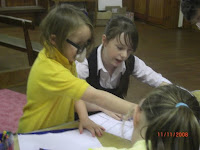
I have recenlty become interested in the work of
Patrick Gedes because it shows the ways in which our environment, whether a rural landscape, or a city dwelling influences our creativity, whether in our manufacturing of technology or in the creation of artistic works. He had a tremendous influence on the development of the city of Edinburgh. The natural features of the city influenced his architectural work as well as his
ideas about town planning.
As I was listening to all of this at the Scottish Storytelling Centre in a joint workshop lead by
Donald Smith and
Bob Pegg it dawned on me that most of my preocupation had so far been on finding techniques to sketch out the macrostructure of stories to the detriment of the context of the story. I resonated very much with the need we have as storytellers to get our audiences to "see" the location where the story takes place. How to use our voice, our gestures and our body language to aid this visualisation is definitely a whole area of inquiry but, and perhaps more poignately, how do we as storytellers work our stories and develop a sense for "seeing" for ourselves, the landscape of our stories?
The physical landscape mapDuring the workshop we were encouraged to visualise, smell and feel the scenery. We were asked to concentrate on particular elements of the landscape that could have an influence in the visualisation that the audience would have. I found this particular exercise very fruitful, since at the moment I am working on a story from the Aztecs and I needed to visualise the famous city of Tenochtitlan (now Mexico City). I was taken as a child by my grandmother to
Zocalo, (the central square, as it was rebuilt by the Spaniards after the fall of Tenochtitlan) however, I had not really thought about how the square would have looked at the time of the Aztecs.
We were then asked to draw a map of the physical landscape of our story. I found that exercise particularly powerful. I realised that a crucial element of my story would have to be a depiction of the central square of
Tenochtitlan. Just as crucial would be the canals, circling the city and providing major commercial waterways connecting the city, which was built on an island on a lake, to the mainland.

I also realised that the market was crucial to the story because the smells and sounds of the market should permeate the story.
After I finished my physical map, I could actually see the central square, with the two main pyramids and the surrounding waterways with barges. The drawing of the map, embedded the square in my mind to the point that all I have to do now, is close my eyes and "see" it. I think that I can now tell what I "see" of this once great but destroyed city, to anyone that listens to my story.
The action mapWe were then asked to use our physical map, and incorporate within it specific actions or sound elements (i.e. movements, music etc) that might help the audience to visualise the environment of the story. I used this opportunity to develop the idea of using clay flutes and perhaps small percussion instruments to introduce a feeling of mystery and hussle and bussle of the market streets adjacent to the ceremonial square.

I also thought of using
scented copal or incense at a specific time within the story to illustrate the significane fo the religious activities being performed at the central square. the action map became a fantastic visual image helping me prepare and "own" my story.
CreditsThe photograph of the clay plaque of Patrick Geddes was taken by
Gary Thomson. The photograph of a painting of Tenochtitlan was taken by
Steve Cadman. The picture of a small representation of the market was taken by
Senor Codo.
 Bookmark this on Delicious
Bookmark this on Delicious












